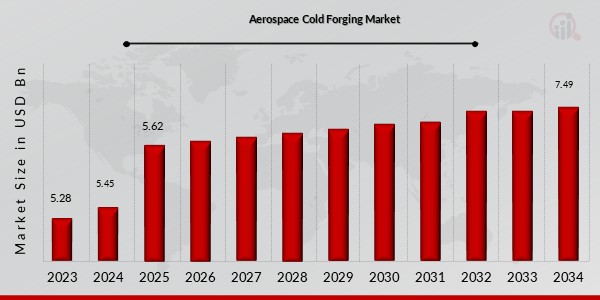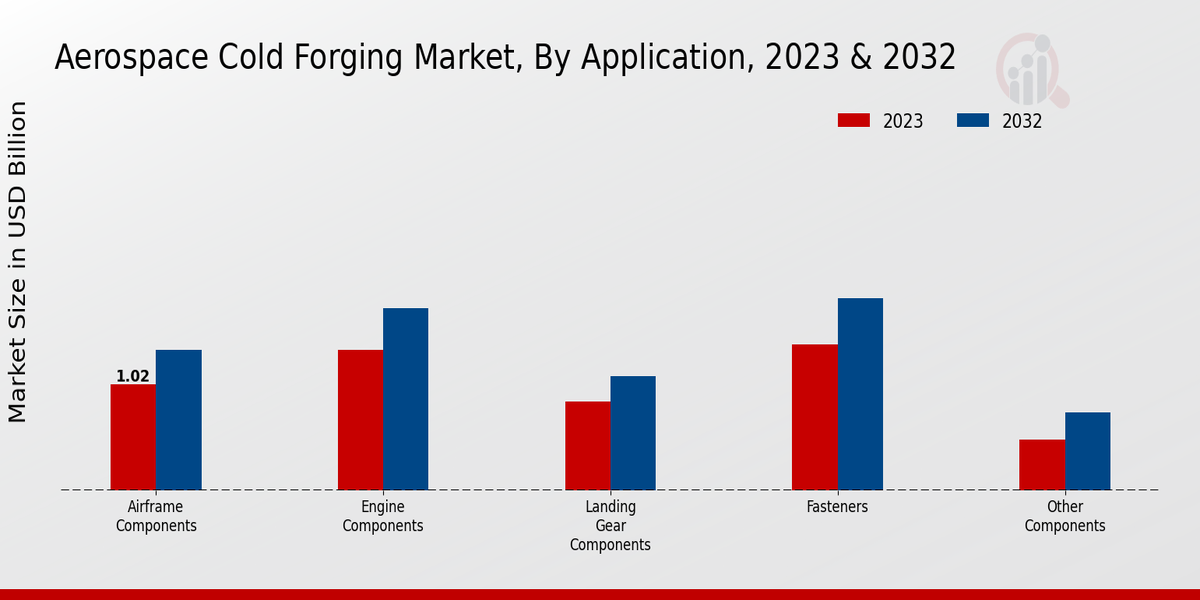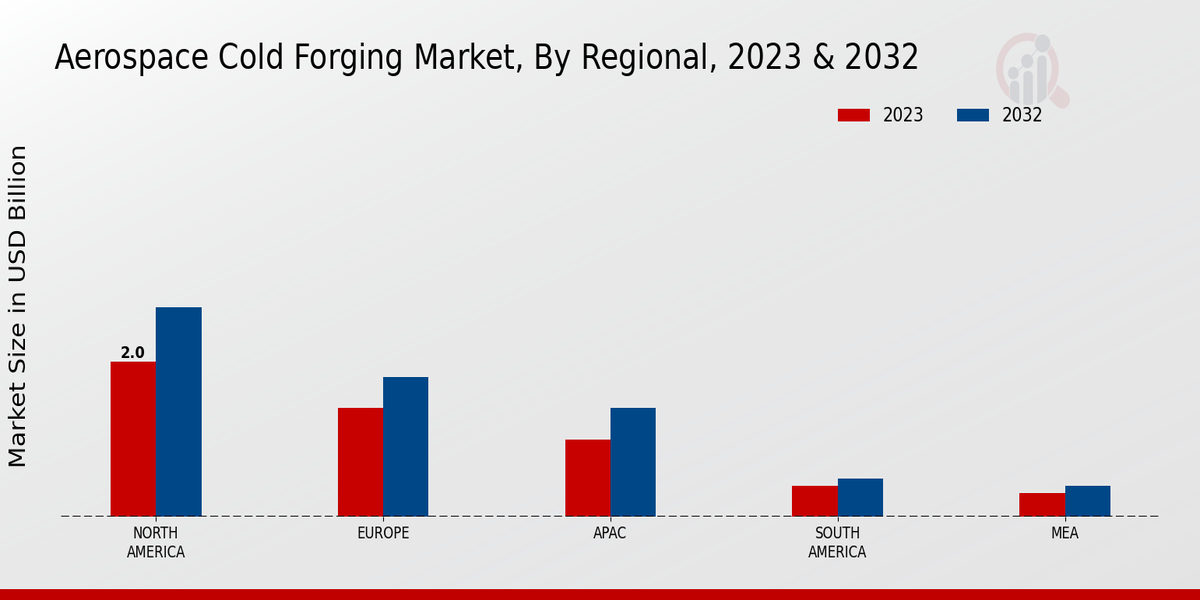Global Aerospace Cold Forging Market Overview
Aerospace Cold Forging Market Size was estimated at 5.45 (USD Billion) in 2024.The Aerospace Cold Forging Market Industry is expected to grow from 5.62 (USD Billion) in 2025 to 7.49 (USD Billion) by 2034. The Aerospace Cold Forging Market CAGR (growth rate) is expected to be around 3.20% during the forecast period (2025 - 2034).

Source Primary Research, Secondary Research, MRFR Database and Analyst Review
Key Aerospace Cold Forging Market Trends Highlighted
The Aerospace Cold Forging Market is driven by several key factors. The growing demand for lighter and more efficient components in aircraft design has prompted manufacturers to explore advanced manufacturing processes. Cold forging is recognized for its ability to produce strong and precise parts with reduced waste. The increasing emphasis on fuel efficiency, along with rising environmental regulations, has further spurred interest in cold-forged components. As aerospace companies aim to enhance their operational efficiencies and reduce costs, the adoption of cold forging in various applications continues to gain momentum. Several opportunities are emerging within the market that could be capitalized on by industry players.
With the rise of electric and hybrid aircraft, there is potential for cold forging to play a significant role in producing specialized components needed for these innovative designs. Moreover, as maintenance and repair activities within the aerospace sector expand, the demand for replacement parts manufactured through cold forging presents an attractive avenue for growth. Collaborations between aerospace manufacturers and cold forging specialists could also lead to advancements in material technology and process optimization. In recent times, the aerospace industry has witnessed an increasing focus on sustainability and reducing carbon footprints.
This trend aligns well with the characteristics of cold forging, which offers more environmentally friendly manufacturing options compared to traditional processes. The integration of Industry 4.0 technologies, such as automation and data analytics, into manufacturing practices, is also shaping the landscape of the cold forging market. Such innovations promise improved efficiency, reduced downtime, and enhanced product quality, ensuring that the aerospace cold forging sector remains resilient and competitive in a rapidly evolving environment.
Aerospace Cold Forging Market Drivers
Increasing Demand for Lightweight Components
The Aerospace Cold Forging Market Industry is currently witnessing a remarkable surge in demand for lightweight components within the aerospace sector. This trend is primarily driven by the ongoing effort to enhance fuel efficiency and reduce emissions from aircraft. As manufacturers strive to meet stringent environmental regulations, the need for lighter materials becomes imperative. Cold forging processes create components that are not only lightweight but also possess superior mechanical properties compared to traditional manufacturing methods.
These advantages allow aerospace engineers to design structures that are both robust and lightweight, resulting in optimized performance during flight. Additionally, the rising emphasis on sustainable aviation practices reinforces the need for advancements in materials used for aircraft manufacturing, bolstering the cold forging market. As a result, players in the Aerospace Cold Forging Market Industry are increasingly investing in research and development to innovate lightweight materials and components, facilitating market growth.Technological Advancements in Manufacturing ProcessesTechnological advancements play a pivotal role in the growth of the Aerospace Cold Forging Market Industry. Innovations in forging technology, along with automation and high-precision manufacturing techniques, enable the production of complex aerospace components with enhanced accuracy and efficiency. This drives down production costs while ensuring that the components meet the rigorous standards of the aerospace sector. Furthermore, advancements in materials science have opened up new avenues for using different alloys and composites, elevating the performance and reliability of cold-forged components in aerospace applications.
Companies that adopt these cutting-edge technologies can improve their competitiveness and cater to the evolving demands of aircraft manufacturers.Rising Investments in Aerospace InfrastructureThe Aerospace Cold Forging Market Industry is significantly influenced by the continuous rise in investments directed towards aerospace infrastructure. Governments and private entities are increasingly funding the development and expansion of airports, aircraft manufacturing facilities, and maintenance, repair, and overhaul (MRO) services. Such investments are critical for enhancing the capacity and capability of the aerospace sector to cater to growing passenger and cargo traffic.
These developments create a heightened demand for high-quality aerospace components, including those produced through cold forging processes. The focus on upgrading existing infrastructure and establishing new facilities not only boosts the overall aerospace market but also paves the way for increased utilization of cold-forged components, contributing positively to market growth.
Aerospace Cold Forging Market Segment Insights
Aerospace Cold Forging Market Application InsightsThe Aerospace Cold Forging Market exhibits significant growth potential across various applications, with an expected valuation reaching 5.11 USD Billion in 2023 and projecting upward to 6.8 USD Billion by 2032. Within the Application segment, several categories, including Airframe Components, Engine Components, Landing Gear Components, Fasteners, and Other Components, play essential roles in the aerospace industry's operational efficiency and safety. Airframe Components are projected to experience steady demand, with their valuation escalating from 1.02 USD Billion in 2023 to 1.35 USD Billion in 2032, underlining their crucial contribution as the framework of aircraft. Engine Components hold a substantial share as well, valued at 1.35 USD Billion in 2023 and anticipated to rise to 1.75 USD Billion by 2032; this segment's growth is largely driven by advancements in engine technology aimed at enhancing performance and efficiency.Landing Gear Components, crucial for the aircraft's operational safety, are valued at 0.85 USD Billion in 2023, growing to 1.1 USD Billion by 2032, showing a significant need for innovation and durability in their designs. Fasteners dominate the market as they ensure the integrity and reliability of various aircraft structures and systems, with a valuation of 1.4 USD Billion in 2023 projected to reach 1.85 USD Billion in 2032, highlighting their essential function in aircraft assembly and maintenance. Other Components, although contributing a smaller share valued at 0.49 USD Billion in 2023 and rising to 0.75 USD Billion by 2032, encapsulate niche applications that support overall aerospace functionality. Collectively, these segments underscore a robust demand influenced by ongoing trends toward lightweight materials, enhanced durability, and advanced manufacturing processes within the Aerospace Cold Forging Market revenue framework, emphasizing the significance of each component in ensuring aircraft reliability and performance. Moreover, the growth drivers, including increased aircraft production rates and the demand for aviation safety, handsomely represent the market's dynamics while also presenting challenges related to production scales and technological innovations. The aforementioned statistics illuminate the Aerospace Cold Forging Market segmentation landscape, reflecting a diverse range of applications critical for the aerospace industry's future.

Source Primary Research, Secondary Research, MRFR Database and Analyst Review
Aerospace Cold Forging Market Material Type InsightsThe Aerospace Cold Forging Market, valued at 5.11 USD Billion in 2023, exhibits a notable focus on the Material Type segment, which includes Aluminum Alloys, Titanium Alloys, Steel Alloys, and Nickel Alloys. Each material offers unique properties that contribute to different applications in the aerospace industry. Aluminum Alloys are typically favored for their lightweight characteristics and corrosion resistance, making them essential for aircraft structures. Meanwhile, Titanium Alloys are recognized for their high strength-to-weight ratio, which is crucial for performance in demanding aerospace applications.
Steel Alloys, known for their durability and ability to withstand high stress, play a significant role in components like landing gears and frames. Nickel Alloys, prized for their heat resistance and strength, are often used in engine components. The Aerospace Cold Forging Market segmentation reflects the diverse needs of the industry, with these materials addressing critical performance requirements and contributing to the overall market growth, aligning with industry trends focused on enhancing fuel efficiency and reducing emissions.
Aerospace Cold Forging Market Process Type InsightsThe Aerospace Cold Forging Market has shown significant dynamics through its Process Type segment, showcasing a diversified approach towards manufacturing. By 2023, the market was valued at approximately 5.11 USD Billion, reflecting a growing demand and operational enhancements in aerospace manufacturing. Within this segment, Single Stroke Forging stands out for its efficiency and cost-effectiveness, playing a crucial role in producing various aerospace components. Multi-Stroke Forging, on the other hand, allows for increased complexity in designs, making it essential for advanced aerospace applications.
Cold Heading is pivotal for creating fasteners and complex shapes, contributing significantly to the reliability of aerospace assemblies. Precision Forging is recognized for its ability to meet strict tolerances and specifications, ensuring high-quality output in aerospace parts. The strong performance of these processes is driven by the rising need for lightweight materials and components in the aerospace industry, while challenges such as technological advancements and ever-evolving regulations require continuous innovation. As a result, these distinct processes collectively enhance the overall efficiency and quality of produced parts, thereby shaping the market's future direction.
The Aerospace Cold Forging Market revenue is expected to continue climbing as these processes adapt to industry demands, emphasizing their significance.
Aerospace Cold Forging Market End Use InsightsThe Aerospace Cold Forging Market focuses on various end-use applications, including Commercial Aviation, Military Aviation, and General Aviation, reflecting its essential role in the aerospace sector. As of 2023, the market value stood at approximately 5.11 USD billion, illustrating significant investment and development in advanced manufacturing processes. Commercial Aviation holds a prominent position, driven by increasing air travel demand and a focus on fuel efficiency, thus supporting the growth of aerospace components that utilize cold forging techniques.
Military Aviation also plays a crucial role, emphasizing the need for robust and lightweight materials, while General Aviation has witnessed consistency in its need for reliable and durable components. The market growth is increasingly propelled by evolving aerospace technologies and rising demand for high-performance materials, while challenges include stringent regulatory requirements and the complexities of supply chain management. Opportunities exist in innovation, particularly in enhancing the precision and efficiency of cold forging processes, which can further solidify the market’s expansion across these significant aviation domains.
The Aerospace Cold Forging Market revenue reflects ongoing advancements and trends, revealing a robust industry poised for continued growth.
Aerospace Cold Forging Market Regional InsightsThe Aerospace Cold Forging Market is projected to garner significant revenue across various regions, showcasing distinctive valuations for each area in 2023. North America dominates the landscape with a market value of 2.0 USD Billion, expected to rise to 2.7 USD Billion by 2032, reflecting its strong aerospace manufacturing sector. Europe follows with a valuation of 1.4 USD Billion in 2023, indicative of its robust aerospace industry and inclination towards advanced manufacturing technologies. The APAC region holds a value of 1.0 USD Billion in 2023, which is growing due to increasing investments in aerospace and rising demand for cost-effective manufacturing solutions.
South America and MEA, while smaller markets with valuations of 0.4 USD Billion and 0.31 USD Billion, respectively, in 2023, are gradually developing, offering opportunities for growth as local industries expand. The Aerospace Cold Forging Market segmentation illustrates a clear regional differentiation, emphasizing North America's majority holding in market share due to its established infrastructure and innovative capabilities. Understanding these dynamics within the Aerospace Cold Forging Market data will facilitate strategic investments and resource allocation in the coming years.

Source Primary Research, Secondary Research, MRFR Database and Analyst Review
Aerospace Cold Forging Market Key Players and Competitive InsightsThe Aerospace Cold Forging Market has been experiencing significant growth due to increasing demand for lightweight and high-strength components in the aerospace sector. Cold forging is a preferred manufacturing process in this industry as it provides superior mechanical properties and reduces material waste. Companies operating in this market are focusing on innovation and technological advancements to enhance production efficiency and product quality. The competitive landscape is characterized by both established players and new entrants, with firms leveraging strategic partnerships, mergers, and acquisitions to strengthen their market position. Additionally, these companies are also investing in research and development to innovate their offerings and meet the evolving needs of aerospace manufacturers, thus driving competition within the market.
GKN Aerospace stands out in the Aerospace Cold Forging Market due to its well-established reputation and extensive experience in advanced engineering solutions. The company is known for its strong emphasis on innovation, continuously investing in new technologies to enhance manufacturing processes and product performance. GKN Aerospace is recognized for its high level of expertise in producing lightweight components, which is critical in the aerospace industry as manufacturers seek to improve fuel efficiency and reduce emissions. The company's robust supply chain and commitment to sustainability also contribute to its competitive advantage, allowing it to meet the rigorous demands of aerospace clients while minimizing environmental impact. GKN Aerospace's strategic collaborations with major airlines and aerospace manufacturers further enhance its market presence and bolster its ability to respond rapidly to changing industry requirements.
Precision Castparts Corp has established itself as a formidable player in the Aerospace Cold Forging Market. The company specializes in manufacturing complex aerospace components that meet stringent quality standards required in the aviation sector. Precision Castparts Corp excels in employing cold forging techniques to produce parts that are both lightweight and structurally sound, catering to the performance needs of diverse aircraft applications. Its focus on innovation is evidenced by ongoing improvements in manufacturing capabilities, which allow for more efficient production processes and better product consistency. The company's extensive portfolio, combined with its strong customer relationships and commitment to operational excellence, positions Precision Castparts Corp as a key competitor in the aerospace cold forging landscape. The strategic investments made by the company in technology and workforce development further solidify its role as a leader in providing critical components to aerospace manufacturers globally.
Key Companies in the Aerospace Cold Forging Market Include
Aerospace Cold Forging Market Industry Developments
In recent developments, the Aerospace Cold Forging Market has been experiencing significant activity, particularly among key players such as GKN Aerospace, Precision Castparts Corp, and Sikorsky Aircraft. The growth in market valuation for companies like Howmet Aerospace and Spirit AeroSystems indicates a positive trend driven by increased demand for lightweight and durable components in aerospace applications. Merger and acquisition activities have been notable, with companies seeking to strengthen their technological capabilities and expand market reach. A reported acquisition involving Arconic and Triumph Group showcases a strategic alignment aimed at enhancing their product portfolios. Additionally, Boeing Commercial Airplanes and Rolls-Royce are actively investing in R&D to boost their competitive positions, notably in response to the increasing shift towards sustainable aviation solutions. Current affairs also highlight partnerships within the industry, as firms like Fastenal and Allied Aerospace collaborate to meet the evolving needs of aerospace manufacturing. The comprehensive integration of advanced technologies into cold forging processes is expected to elevate production efficiency, further impacting the overall competitiveness of this market sector.
Aerospace Cold Forging Market Application Outlook
- Airframe Components
- Engine Components
- Landing Gear Components
- Fasteners
- Other Components
Aerospace Cold Forging Market Material Type Outlook
- Aluminum Alloys
- Titanium Alloys
- Steel Alloys
- Nickel Alloys
Aerospace Cold Forging Market Process Type Outlook
- Single Stroke Forging
- Multi-Stroke Forging
- Cold Heading
- Precision Forging
Aerospace Cold Forging Market End Use Outlook
Aerospace Cold Forging Market Regional Outlook
- North America
- Europe
- South America
- Asia Pacific
- Middle East and Africa
|
Report Attribute/Metric
|
Details
|
|
|
|
|
Market Size 2024
|
5.45(USD Billion)
|
|
Market Size 2025
|
5.62(USD Billion)
|
|
Market Size 2034
|
7.49(USD Billion)
|
|
Compound Annual Growth Rate (CAGR)
|
3.20% (2025 - 2034)
|
|
Report Coverage
|
Revenue Forecast, Competitive Landscape, Growth Factors, and Trends
|
|
Base Year
|
2023
|
|
Market Forecast Period
|
2024 - 2032
|
|
Historical Data
|
2019 - 2023
|
|
Market Forecast Units
|
USD Billion
|
|
Key Companies Profiled
|
GKN Aerospace, Precision Castparts Corp, Sikorsky Aircraft, Allied Aerospace, Triumph Group, Howmet Aerospace, Fastenal, Arconic, RollsRoyce, AstraZeneca, Kewadin Productions, Kaman Aerospace, Spirit AeroSystems, Horizon Global Corporation, Boeing Commercial Airplanes
|
|
Segments Covered
|
Application, Material Type, Process Type, End Use, Regional
|
|
Key Market Opportunities
|
Rising aircraft production rates, Increasing demand for lightweight components, Technological advancements in forging processes, Strengthening regulations for safety standards, Growing focus on fuel efficiency
|
|
Key Market Dynamics
|
rising demand for lightweight components, increasing aircraft production rates, advancements in forging technology, stringent aerospace regulations, growing focus on operational efficiency
|
|
Countries Covered
|
North America, Europe, APAC, South America, MEA
|
Frequently Asked Questions (FAQ) :
The Aerospace Cold Forging Market is expected to be valued at approximately 7.49 USD Billion by 2034.
The expected CAGR for the Aerospace Cold Forging Market from 2024 to 2034 is 3.20%.
In 2023, the market size for Airframe Components in the Aerospace Cold Forging Market is valued at 1.02 USD Billion.
North America holds the largest market share in the Aerospace Cold Forging Market with a value of 2.0 USD Billion in 2023.
The expected market size for Engine Components in the Aerospace Cold Forging Market is projected to reach 1.75 USD Billion by 2032.
Significant players in the Aerospace Cold Forging Market include GKN Aerospace, Precision Castparts Corp, and RollsRoyce, among others.
By 2032, the anticipated market value for Fasteners in the Aerospace Cold Forging Market is expected to be 1.85 USD Billion.
The Aerospace Cold Forging Market is valued at 1.0 USD Billion in the APAC region for the year 2023.
Challenges in the Aerospace Cold Forging Market may include technological advancements and competition from alternative manufacturing processes.
The expected market size for Landing Gear Components in the Aerospace Cold Forging Market is projected to be 1.1 USD Billion by 2032.

















